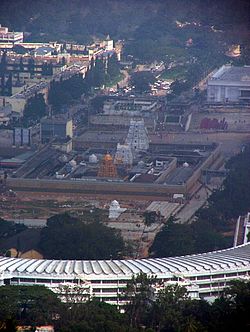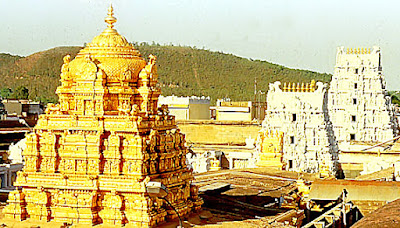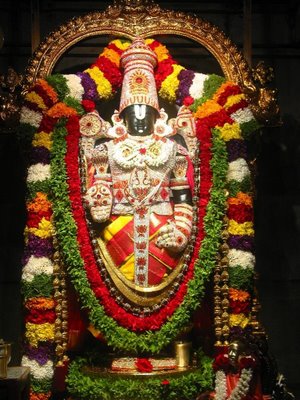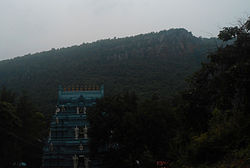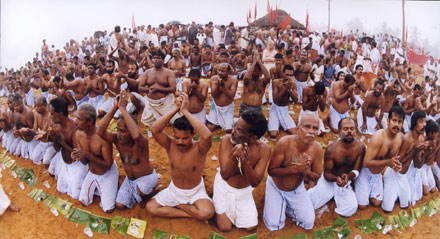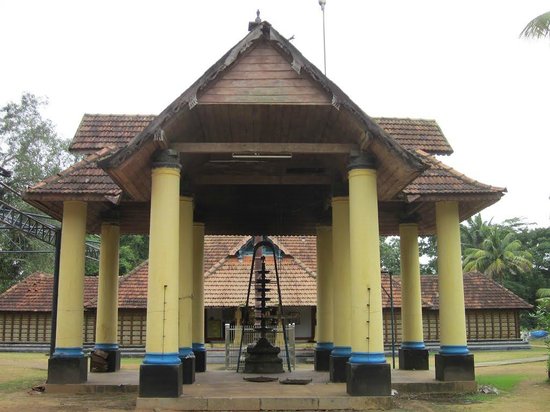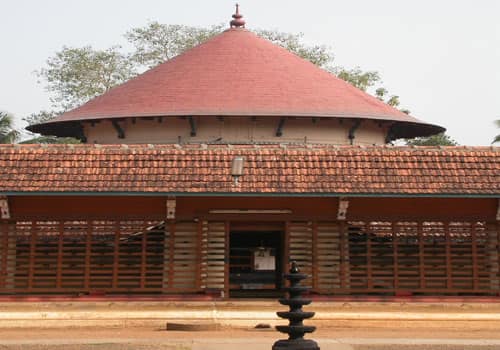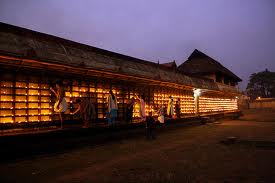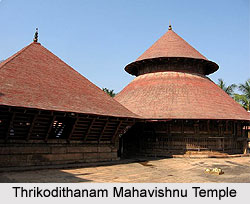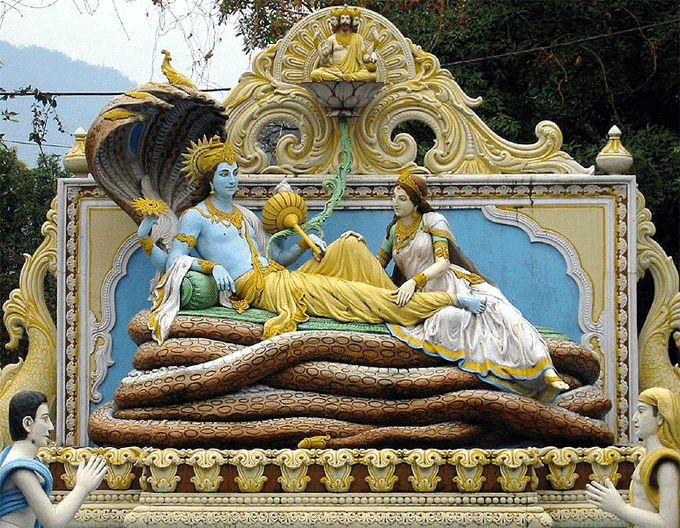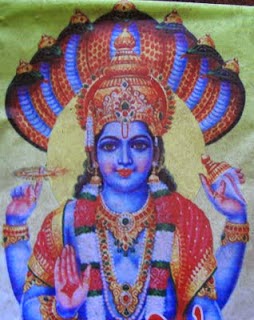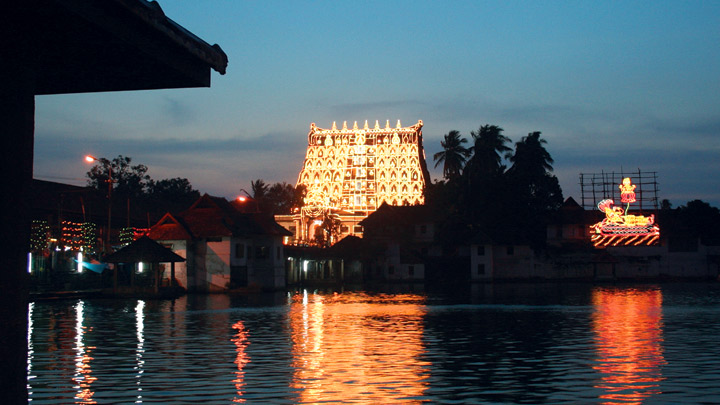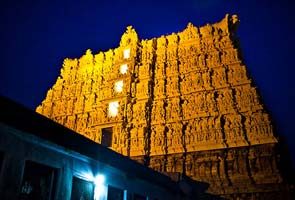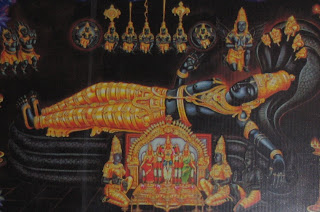P.J.
0
Divya Desam75- Sri Tirumala Venkateswara Temple Continues
Divya Desam75- Sri Tirumala Venkateswara Temple Continues
OM NAMO VENKATESAYA
Sthala Puranam:
Emperumaan, Sriman Narayanan is found as "Eazhumalayaan" stands in this temple all alone in Nindra thirukkolam and is giving the seva to lots and lots of Bhaktas. After the world has been created, Trethayugham, Dwaparayugam and Krithayugam all went and in all these yugam, as stated by Sriman Narayanan in Mahabharatham, he took Avathaar in some form to establish Dharmam and fought and destroyed "Adharmam" or evil.
After all these Yugams finished, Kali yugam started from hem all sorts of Evil things started to spread along throughout the world. Great Emporers lost their Empire and lots of Yogis and rishis were killed and their wives were captured by Arakkas (Demon). At that Kaliyugam, a wild demon by named "kali" emerged in this yugam who made the earth loose its beauty and spread various evil aspects in the midst of the human minds.
In Kaliyugam, person who has money and body strength are respected and all the good things like human relationship, guru and his students relation, cheating others for money and lots of sinful action were performed.
Lord Brahma was so scared on seeing the Earth in this manner. Finally he thought, the right person to cure this is Sriman Narayanan and if his divine thiruvadi (feet) is touched on the lands of earth, it might regain its lost beauty and if atleast a drop of his blood is shed on earth, the earth become pure and thereby all evil things might diminish. He said this to Narada Maharishi and he should take of this.
 All the Maharishis had a meeting that a very big Yaagam must be done and how much amount credit should be given to which god? Naradar told that it should be given to one among the 3 moorthies who stands as the structure of Dharma and Sathyam and he should be capable of withstanding all sorts of Adharmams. Finally, he ends by saying that Brighu Maharishi is the right person who can do this in finding among the 3 Moorthies who is person with the said Characters.
All the Maharishis had a meeting that a very big Yaagam must be done and how much amount credit should be given to which god? Naradar told that it should be given to one among the 3 moorthies who stands as the structure of Dharma and Sathyam and he should be capable of withstanding all sorts of Adharmams. Finally, he ends by saying that Brighu Maharishi is the right person who can do this in finding among the 3 Moorthies who is person with the said Characters.
First, he went straight to Siva logam where Lord Shiva and Parasakthi are found closed to each other. It is one of the Universal truth that the union of Shivan and Sakthi is said to be the way made for the Dharmam to come all its way. But, since Brighu Maharishi was so angry that his presence was not being noticed, and gave him the Sabham that on the earth, Lord Shivan would be done pooja only in the form of Lingam but not in the form of Statues (or) Vigrahams (Idols). This is the only reason that Shiva Lingams are found in all Shiva temples but not Idols,
After this, Brighu Maharishi went to Brahma devan's Sathya logam. There also he was not greeted properly not he was not noticed. It was him, Brahma devan who asked Narada Maharishi for this to happen but it is fate that all this should happen. After being not noticed by Brahma and Saraswathi, Brighu Maharishi got angry on him and like the same way, as he gave Sabham for Shivan, he gave Brahma devan a sabham that there should be no temple for Brahma in the Bhoologam and after this he went straight to Vaikundam.
After entering into Vaikundam, he saw Sriman Narayanan sleeping in Aadhiseshan. He could not be so calm since he was not greeted and taken care properly by Brahma devan and as a result he had given them the Sabham.
As a result, he burst out like Volcano and went straight towards Sriman Narayanan and kicked him on his Thirumaarbhu (divine chest). After being kicked, Sriman Narayanan woke up and asked Brighu Maharishi to sit and did Padha pooja for him. Brighu Maharishi is a person who has an eye on his feet. Because of this he was so angry and the perumal plucked the eye from his feet and as a result he lost all of his anger and finally thought that all of the Yoga credit must be given to Sriman Narayanan and came to the Yoga place.
As we can notice, it was Brahma devan that who started the process of finding to whom the yaga credit should be given but finally he was given the sabham that he should not be worshiped in the earth. Its all a written one and it is fate that these are the things that should happen.
But, as Brighu Maharishi kicked the thirumaarbhu (divine chest) of Sriman Narayanan, Lakshmi piratti left him from Sri Vaikundam and came towards the earth. Because of this, Sri Vaikundam, the Moksham lost its grace and brightness and all of these are said to be only because of Kaliyugam.
After being alone in Vaikundam, Sri Vishnu could not be in Vaikundam and came towards the Bhoologam in search of Sri Mahalakshmi. Aadhiseshan turned as the mountain of Tirumala and the perumal roamed all along the earth without knowing what to do. He forgot all of his duties and he lost his conscious and sat like a person without having food, water and anything else.
On seeing this, Brahma devan and Shivaperuman came down towards the Bhoologam as a cow and calf and were finally handed over towards the Chozha king.
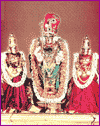 Once an cowherd person took the cow and the calf for making them to eat. But in the land, the cow (Brahma devan) and the calf (Shiva peruman) went towards the putru (a small mountain surrounded by sand), where Sri Vishnu was found. The cow and the calf went towards the putru and gave Sriman Narayanan the milk. This happened daily. But the cowherd could not understand why this particular cow is not giving milk while the other do. so, finally he made up in his mind that he should follow the cow and the calf and whats the reason for not giving milk.
Once an cowherd person took the cow and the calf for making them to eat. But in the land, the cow (Brahma devan) and the calf (Shiva peruman) went towards the putru (a small mountain surrounded by sand), where Sri Vishnu was found. The cow and the calf went towards the putru and gave Sriman Narayanan the milk. This happened daily. But the cowherd could not understand why this particular cow is not giving milk while the other do. so, finally he made up in his mind that he should follow the cow and the calf and whats the reason for not giving milk.
The next day he took all the cows for the grass to the plains but his eyes was watching only the cow (Brahma) thats not giving milk daily. As a daily practice, the spiritual cow went towards the Putru and gave all of the milk inside it, where Sriman Narayanan is found.
On seeing this, the cowherd went to the Chozha and told the reason why the cow is not yielding milk. Then, the king sent some of his soldiers and asked them to destroy the Putru. On that time, the cow asusual went towards the Putru and gave milk. But at the same time, the cowherd tried to hit the cow with his axe and because of this, he threw the axe towards the cow. But, to help the cow, the perumal came out from the Putru and held the axe in his head. The axe directly struck the forehead of the perumal and made a deep cut and as a result, the blood came out and finally it fell on the earth and thus, finally the earth was freed from all sorts of evil activities thats being done by Kalki.
As the Emperumaan divine feet was stamped on the Bhoologam, it got its purity and the perumal gave his seva first to the cowherd inspite of throwing the axe on him and made wound on him. But, as said by the perumal in Bagavath Gita, "Do your duties, without expecting the return". As said by the perumal, the cowherd did the right duty of stopping the cow which gave the milk to the perumal. He didnt expected anything. Its his duty to take the cow out and get the milk from them. As a result, he was the first person to get the dharshan of the perumal.
Varaghar and Sri Srinivasar:
After coming out from the Putru, the perumal went towards Sri Varagha moorthy who helped out Bhoomipiratti from Hiranyatshakan, when the perumal took the Avathar as "Sri Varaghar". The perumal asked for some place to stay in the hill. As Varaghar could easily feel that the perumal is feeling the absence of Lakshmi piratti, he offered the perumal some land on the hill and he asked for a varam. It is that every bhaktas should worship Varagha swamy first then only they should worship the Sri Srinivasa perumal.
If they worship him directly with praying Varagha moorthy, the perumal should not give his blessing nor take their offerings. The perumal accepted it and promised him that the Prasadham and his darshan will be offered first to Varagha moorthy and then only it would be offered to the perumal in Tirupathi. Thus, the perumal got the place to stay on and this hill is the Venkatachala hill (Tirumala). Varagha moorthy also sent Vakula maligai along with the perumal to help him out in the house. Vakula maligai is none other than Yasodha the mother of Sri Krishnan in Sri Krishna Avathaar. During that avathaar, the perumal had promised her that in Kali Yugam that she will be given his seva and she will be seeing the perumal in Kalyana Vaibhavam, as Kalyana Moorthy.
OM NAMO NARAYANA
http://www.divyadesam.com/hindu/temples/andhra/tirumala-sthpuranam.shtml
TO BE CONTINUED
Divya Desam75- Sri Tirumala Venkateswara Temple Continues
OM NAMO VENKATESAYA
Sthala Puranam:
Emperumaan, Sriman Narayanan is found as "Eazhumalayaan" stands in this temple all alone in Nindra thirukkolam and is giving the seva to lots and lots of Bhaktas. After the world has been created, Trethayugham, Dwaparayugam and Krithayugam all went and in all these yugam, as stated by Sriman Narayanan in Mahabharatham, he took Avathaar in some form to establish Dharmam and fought and destroyed "Adharmam" or evil.
After all these Yugams finished, Kali yugam started from hem all sorts of Evil things started to spread along throughout the world. Great Emporers lost their Empire and lots of Yogis and rishis were killed and their wives were captured by Arakkas (Demon). At that Kaliyugam, a wild demon by named "kali" emerged in this yugam who made the earth loose its beauty and spread various evil aspects in the midst of the human minds.
In Kaliyugam, person who has money and body strength are respected and all the good things like human relationship, guru and his students relation, cheating others for money and lots of sinful action were performed.
Lord Brahma was so scared on seeing the Earth in this manner. Finally he thought, the right person to cure this is Sriman Narayanan and if his divine thiruvadi (feet) is touched on the lands of earth, it might regain its lost beauty and if atleast a drop of his blood is shed on earth, the earth become pure and thereby all evil things might diminish. He said this to Narada Maharishi and he should take of this.

First, he went straight to Siva logam where Lord Shiva and Parasakthi are found closed to each other. It is one of the Universal truth that the union of Shivan and Sakthi is said to be the way made for the Dharmam to come all its way. But, since Brighu Maharishi was so angry that his presence was not being noticed, and gave him the Sabham that on the earth, Lord Shivan would be done pooja only in the form of Lingam but not in the form of Statues (or) Vigrahams (Idols). This is the only reason that Shiva Lingams are found in all Shiva temples but not Idols,
After this, Brighu Maharishi went to Brahma devan's Sathya logam. There also he was not greeted properly not he was not noticed. It was him, Brahma devan who asked Narada Maharishi for this to happen but it is fate that all this should happen. After being not noticed by Brahma and Saraswathi, Brighu Maharishi got angry on him and like the same way, as he gave Sabham for Shivan, he gave Brahma devan a sabham that there should be no temple for Brahma in the Bhoologam and after this he went straight to Vaikundam.
After entering into Vaikundam, he saw Sriman Narayanan sleeping in Aadhiseshan. He could not be so calm since he was not greeted and taken care properly by Brahma devan and as a result he had given them the Sabham.
As a result, he burst out like Volcano and went straight towards Sriman Narayanan and kicked him on his Thirumaarbhu (divine chest). After being kicked, Sriman Narayanan woke up and asked Brighu Maharishi to sit and did Padha pooja for him. Brighu Maharishi is a person who has an eye on his feet. Because of this he was so angry and the perumal plucked the eye from his feet and as a result he lost all of his anger and finally thought that all of the Yoga credit must be given to Sriman Narayanan and came to the Yoga place.
As we can notice, it was Brahma devan that who started the process of finding to whom the yaga credit should be given but finally he was given the sabham that he should not be worshiped in the earth. Its all a written one and it is fate that these are the things that should happen.
But, as Brighu Maharishi kicked the thirumaarbhu (divine chest) of Sriman Narayanan, Lakshmi piratti left him from Sri Vaikundam and came towards the earth. Because of this, Sri Vaikundam, the Moksham lost its grace and brightness and all of these are said to be only because of Kaliyugam.
After being alone in Vaikundam, Sri Vishnu could not be in Vaikundam and came towards the Bhoologam in search of Sri Mahalakshmi. Aadhiseshan turned as the mountain of Tirumala and the perumal roamed all along the earth without knowing what to do. He forgot all of his duties and he lost his conscious and sat like a person without having food, water and anything else.
On seeing this, Brahma devan and Shivaperuman came down towards the Bhoologam as a cow and calf and were finally handed over towards the Chozha king.

The next day he took all the cows for the grass to the plains but his eyes was watching only the cow (Brahma) thats not giving milk daily. As a daily practice, the spiritual cow went towards the Putru and gave all of the milk inside it, where Sriman Narayanan is found.
On seeing this, the cowherd went to the Chozha and told the reason why the cow is not yielding milk. Then, the king sent some of his soldiers and asked them to destroy the Putru. On that time, the cow asusual went towards the Putru and gave milk. But at the same time, the cowherd tried to hit the cow with his axe and because of this, he threw the axe towards the cow. But, to help the cow, the perumal came out from the Putru and held the axe in his head. The axe directly struck the forehead of the perumal and made a deep cut and as a result, the blood came out and finally it fell on the earth and thus, finally the earth was freed from all sorts of evil activities thats being done by Kalki.
As the Emperumaan divine feet was stamped on the Bhoologam, it got its purity and the perumal gave his seva first to the cowherd inspite of throwing the axe on him and made wound on him. But, as said by the perumal in Bagavath Gita, "Do your duties, without expecting the return". As said by the perumal, the cowherd did the right duty of stopping the cow which gave the milk to the perumal. He didnt expected anything. Its his duty to take the cow out and get the milk from them. As a result, he was the first person to get the dharshan of the perumal.
Varaghar and Sri Srinivasar:
After coming out from the Putru, the perumal went towards Sri Varagha moorthy who helped out Bhoomipiratti from Hiranyatshakan, when the perumal took the Avathar as "Sri Varaghar". The perumal asked for some place to stay in the hill. As Varaghar could easily feel that the perumal is feeling the absence of Lakshmi piratti, he offered the perumal some land on the hill and he asked for a varam. It is that every bhaktas should worship Varagha swamy first then only they should worship the Sri Srinivasa perumal.
If they worship him directly with praying Varagha moorthy, the perumal should not give his blessing nor take their offerings. The perumal accepted it and promised him that the Prasadham and his darshan will be offered first to Varagha moorthy and then only it would be offered to the perumal in Tirupathi. Thus, the perumal got the place to stay on and this hill is the Venkatachala hill (Tirumala). Varagha moorthy also sent Vakula maligai along with the perumal to help him out in the house. Vakula maligai is none other than Yasodha the mother of Sri Krishnan in Sri Krishna Avathaar. During that avathaar, the perumal had promised her that in Kali Yugam that she will be given his seva and she will be seeing the perumal in Kalyana Vaibhavam, as Kalyana Moorthy.
OM NAMO NARAYANA
http://www.divyadesam.com/hindu/temples/andhra/tirumala-sthpuranam.shtml
TO BE CONTINUED

